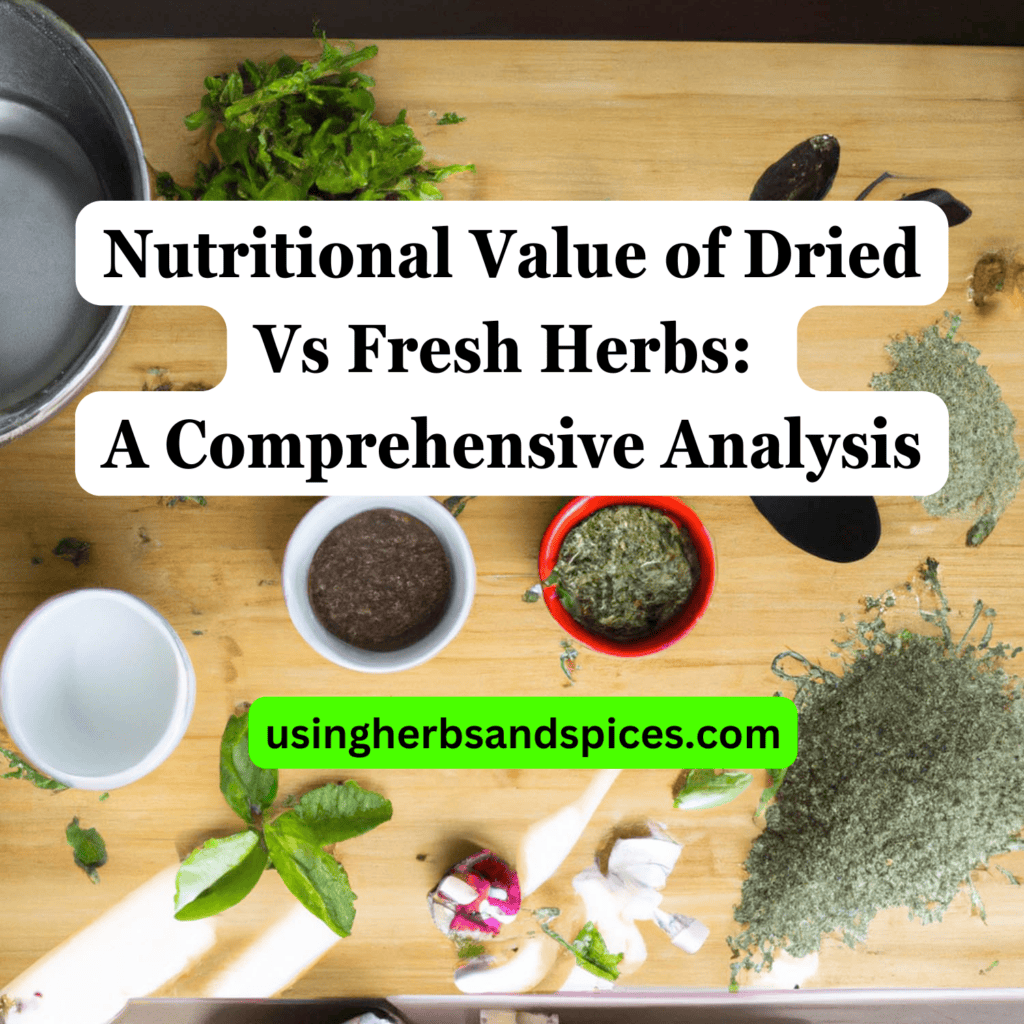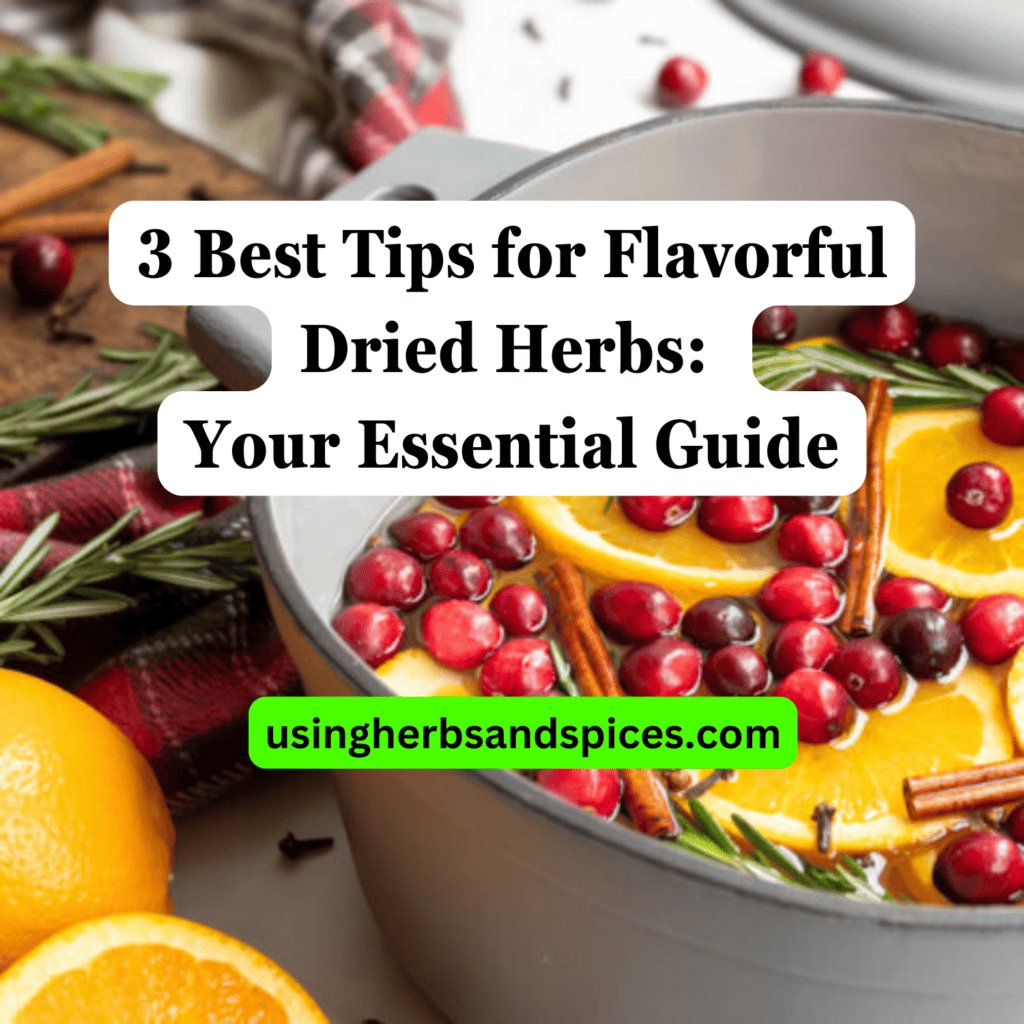SUMMARY: Drying herbs can alter their nutritional content, introducing significant differences compared to their fresh counterparts. However, factors like convenience, shelf life, and cooking techniques should also be considered in the decision making; detailed nutritional profiles of widely-used dried herbs like basil, parsley, and oregano are discussed to provide a clear picture.
Ever wondered how the nutritional composition of your favorite herbs changes after they’ve been dried?

This article will dive deep into the world of dried versus fresh herbs from a nutritional perspective.
- The process of drying herbs and its impact on nutritional content.
- Surprising comparisons of nutritional value between dried and fresh herbs.
- Factors to consider when choosing fresh over dried, and vice versa.
- Nutritional profiles of some commonly used dried herbs.
Reading this, you would be able to make an informed decision about which form of herbs you should use for your culinary explorations and health benefits.
The Process of Drying Herbs
Drying herbs is a practice that dates back to ancient times, and involves removing the water content from herbs to preserve them for longer periods. This process is often done naturally under the sun, though modern methods like oven and dehydrator drying have become more popular. During this process, the water content evaporates, leaving behind the concentrated essence and nutrients of the herbs.
While some nutrients like vitamin C are often lost during the drying process due to their vulnerability to heat and air exposure, other nutrients tend to concentrate, enhancing certain health benefits. It’s important to note that the nutrient loss or concentration can differ depending on the type and freshness of the herbs, as well as the drying method used.
With this understanding, let’s delve deeper into how the nutritional content shifts between dried and fresh herbs, providing you with the information needed to make wise decision for your health and culinary applications.
Interesting Comparison of Nutritional Value Between Dried and Fresh Herbs
When looking at the nutritional content of herbs, one might expect fresh herbs to hold an upper hand. After all, they are undeniably vibrant and green, hinting at their richness in nutrients. However, the story is a bit more complicated. Although fresh herbs are indeed packed with vitamins and antioxidants, drying herbs can significantly concentrate their nutritional values.
In many cases, dried herbs contain higher amounts of nutrients per gram due to their reduced water content. Hence, you can obtain the same or even a higher amount of nutrients in less volume. To illustrate, a spoonful of dried oregano can pack more antioxidants than a bundle of fresh oregano.
Moreover, while some vitamins, like vitamin C, are less stable and can diminish during the drying process, many other nutrients, such as dietary fiber and minerals, remain intact. Additionally, some volatile compounds responsible for the potent flavors and aromas, which also contribute to the herb’s health benefits, tend to be more concentrated in dried herbs.
Despite the above, the story is not that cut and dried. There is an important caveat – the quality of the drying process. Improper drying can lead to nutrient loss, while a suitably controlled process can enhance nutritional preservation.
Overall, we can see that dried herbs can have a surprising nutritional punch, often overshadowing their fresh counterparts. However, the optimized mix of dried and fresh herbs in your diet can provide a more holistic array of nutrients.
Factors to Consider When Choosing Between Dried and Fresh
While nutritional content is undoubtedly a crucial part of opting for dried or fresh herbs, one cannot discount other factors. Not every culinary decision is purely based on the nutritional value of an ingredient, other elements, like convenience and taste, often play a significant role.
When it comes to convenience, dried herbs outshine fresh ones. Dried herbs are a pantry staple because they have a long shelf life and can be stored for extended periods of time without losing their flavor. This makes them a fantastic option for those who cannot replenish their supply of fresh herbs regularly.
Moreover, the shelf life of dried herbs makes them a cost-effective option, as well. Since they can be stored for a longer time, there’s less risk of waste due to spoilage.
However, that’s not to say fresh herbs don’t bring their own benefits to the table. Fresh herbs are generally considered more vibrant and robust in flavor compared to their dried counterparts. They can elevate a simple dish into a gourmet feast with their distinct and potent taste.
Cooking techniques also might dictate whether you use fresh or dried herbs. Some meals require the subtleness and the texture of fresh herbs, while others need the concentrated flavor of dried herbs, especially in slow-cooked dishes.
In conclusion, it’s about balancing flavor, convenience, and nutritional value when deciding between fresh and dried herbs. Both forms importantly have their role in the culinary world and can be used interchangeably based on needs and requirements.
Exploring the Nutritional Profile of Specific Dried Herbs
Given the general understanding of how drying herbs affects their nutritional content, let’s take a look at the nutritional profiles of three popular dried herbs – basil, parsley, and oregano.
Dried Basil
Basil, particularly its dried version, is rich in vitamin K which is vital for blood clotting and bone health. It also contains certain other minerals like calcium, manganese, and iron. Moreover, dried basil possesses a higher concentration of essential oils delivering a potent flavor.
Dried Parsley
Parsley is another herb that packs nutrients even in its dried form. High in vitamins A and C, dried parsley can contribute significantly towards enhancing your immunity. Furthermore, it provides a good source of folic acid, an essential vitamin for heart health.
Dried oregano
Dried oregano is arguably one of the most nutritionally dense dried herbs. It is loaded with antioxidants which can help combat free radicals in the body. Additionally, it is high in dietary fiber, vitamin K, calcium, iron, and a host of other minerals.
While these are just a few examples, one can see how even after the drying process, these herbs retain significant amounts of vitamins and minerals. Consequently, whether you’re garnishing your pizza with dried oregano, spicing up your soup with dried basil, or adding a dash of dried parsley to your salad, you’re adding a host of nutrients to your dishes.
Dried Vs Fresh – A Nutrition Standoff
To conclude, whether fresh or dried, herbs bring something unique to the table when it comes to their nutritional profiles.
- The drying process transforms the nutritional content of herbs in a substantial way.
- There are noteworthy differences in the nutritional values between fresh and dried herbs.
- Factors such as convenience, shelf life, and cooking techniques also play a part in choosing between the two.
- The nutritional profiles of specific dried herbs like basil, parsley and oregano are rich and vibrant, despite their dried state.
In the end, the choice between fresh and dried herbs largely boils down to personal preference and specific cooking needs without compromising much on nutrition. Both sides of the divide bring forth remarkable flavors and nutritional benefits, ensuring that no matter what you choose, your diet will thank you.
Dried Vs Fresh: 7 Key Nutritional Comparisons FAQs
What happens to herbs when they are dried?
Herbs undergo a transformation when dried, not just in terms of texture, but in their nutritional content as well. The drying process decreases moisture content, which can enhance the concentration of certain nutrients and alter the ratios of other components. More specifically, drying leads to a significant reduction in vitamin C content, while potentially increasing concentrations of fiber and mineral content.
Are there significant differences in nutritional value between dried and fresh herbs?
Yes, the nutritional value between dried and fresh herbs does vary significantly. Fresh herbs are often richer in vitamins such as vitamin C, due to its sensitivity to heat and light. On the other hand, dried herbs may contain enhanced levels of certain minerals and fiber due to their concentration during the drying process. It is important to note that both fresh and dried herbs contribute valuable nutrients to our diet.
What factors should I consider when choosing between dried and fresh herbs?
When opting between dried and fresh herbs, multiple factors should be considered beyond just nutritional value, including convenience, shelf life, and even specific cooking techniques. For instance, fresh herbs often provide a vibrant flavor and visual appeal, ideal for finishing dishes, while dried herbs can impart deeper or more concentrated flavors, making them well suited to longer cooking methods.
Do dried herbs like basil, parsley and oregano still contain nutritional benefits?
Yes, dried herbs like basil, parsley, oregano, and others retain valuable nutritional properties, despite undergoing the drying process. These herbs can still be excellent sources of dietary fiber, iron, calcium, and even certain vitamins (like vitamin K), proving that they can contribute positively to our daily nutritional intake.









